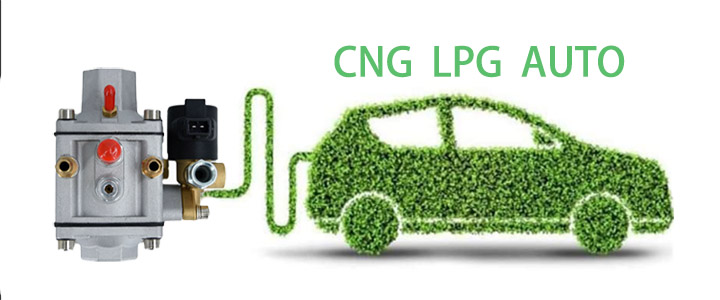Advantages of CNG vehicle system conversion
A vehicle that uses compressed natural gas (CNG) as fuel for automobiles is called a CNG vehicle. For in use vehicles, the standardized gasoline vehicle is modified and a dedicated compressed natural gas device is added while retaining the original fuel supply system, forming a "CNG dual fuel vehicle". The fuel transfer only requires a toggle switch. Adding natural gas once can travel about 200 kilometers, especially suitable for buses, city taxis, minibuses with a round-trip distance of no more than 200 kilometers, vans, and other vehicles in the workplace. What have you and the people around you gained from CNG conversion? CNG provides a convenient and cost-effective alternative solution that can reduce the emissions generated by the engine. Among all alternative fuels (CNG, LPG, hydrogen), compressed natural gas (CNG) is the most practical. It is easy to obtain, burns clean, and safe. Let's talk about each of these points.

Ready to use, reasonably priced fuel
Natural gas usually exists in underground reservoirs together with crude oil. Although traditional crude oil reserves are decreasing, new drilling and extraction technologies have released enormous natural gas resources trapped in previously uneconomical shale deposits. Due to the fact that natural gas can be compressed into liquid fuel suitable for internal combustion engines, it can permanently break dependence on foreign oil by turning to CNG powered vehicles.
Emission benefits
Natural gas is a cleaner combustion fuel than coal, diesel, or gasoline because it has lower carbon content and fewer impurities. It produces less carbon dioxide (CO2), sulfur dioxide (SO2- the main cause of acid rain), and nitrous oxide (NOx).
The greenhouse gas emissions generated by internal combustion engines using natural gas are 22% and 29% lower than those using diesel or gasoline, respectively. Electric vehicles have recently made a lot of headlines, not to mention the huge capital investments of entrepreneurs and major car manufacturers. However, they only transfer the emissions from the engine exhaust tailpipes to the place of power generation and the manufacturing location of the components used (such as batteries).
When you observe the total emissions of electric vehicles, they are not so optimistic - even if you can charge them with 100% wind, solar, or hydrogen energy. Using CNG as the main fuel, producing 1 mmBTU of energy can produce 117 pounds of carbon.
In a typical energy structure, the same amount of electricity generates 183 pounds of carbon, as 62% of power generation fuels are still carbon based (24% of the country's electricity still comes from coal, which has the highest carbon footprint and other impurity levels among all power generation fuels). Even worse, the efficiency of the distribution network is extremely low. Due to transmission and conversion losses, on average, every electric vehicle that actually reaches an electric vehicle must generate nearly three units of energy.Finally, in order to approach Apple's comparison with Apple as closely as possible, we need to include emissions related to battery manufacturing.

Safety problem
In the eyes of some people, adding a CNG canister to the trunk or cargo hold of a car can turn it into a "rolling bomb". This is far from the truth.
When a gasoline powered car experiences an accident, any spilled fuel will form puddles around the wreckage. When a puddle ignites, it can cause dangerous fires, burn down vehicles, and in the worst-case scenario, even burn down passengers on board.
When a compressed natural gas storage tank is punctured, the gas will immediately be depressurized because it is lighter than air, so it will quickly dissipate. The fire ran out of fuel.
If the fuel tank is intact but the vehicle catches fire, the pressure relief device (PRD) will prevent the fuel tank from exceeding its rated pressure and exploding. In addition, CNG storage tanks need to pass a fire survival test, in which they are exposed to direct propane flames for at least 20 minutes without failure.

Maintenance and emission testing
As an alternative fuel for clean combustion, CNG will reduce maintenance on some of the most expensive components of cars. Compressed natural gas conversion will not damage your engine, it will keep the engine clean, thus saving real money. Due to the CNG kit converting your vehicle to a dual fuel system, there is no need to make any adjustments or interference to the original engine management system or sensors, so you can run the engine on gasoline and conduct emission testing normally. Alternatively, if allowed, you can use CNG to run the engine during testing and utilize the lower emissions generated by CNG compared to gasoline.
Bottom line
CNG conversion is the most cost-effective, safe, and effective way to reduce engine emissions. Unlike switching to electric vehicles, there is no need to replace the current vehicle, and your emissions will also be known, regardless of where you purchase electricity or the inefficiency of the distribution network.
 Refer to:https://www.bglgas.com/cng-advantages/
Refer to:https://www.bglgas.com/cng-advantages/
The pictures and articles are from the internet. If there is any infringement, please contact us to delete them.
Popular articles
-

How the CNG Automotive S
Compressed natural gas (CNG) automotive systems
-

Advantages Of CNG Gas V
Compressed natural gas vehicles are vehicles th
-

What Is CNG Pressure Red
The pressure reducer of natural gas vehicle is
-

Advantages And Principle
LPG and CNG are two mainstream alternati
-

Reasons For High Gas Con
1. Original vehicle condition A. The tec
-

How To Improve The Power
1. Install ignition advance angle What i
-

Differences Between Sing
Characteristics of Gas Single Point Device
-

How The CNG Gas Vehicle
If you want to know ¨C how does the CNG conversi






Latest comments
0piece comment
no comments, welcome to comment¡£